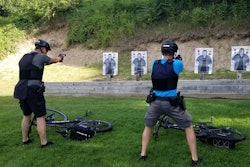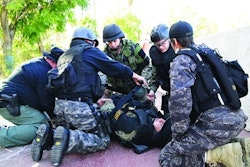Many aspects of law enforcement training replicate realistic situations officers might encounter on the street. Role-playing "force-on-force" simulation is usually considered to be optimal, but it is also the most expensive, time-consuming, and difficult to do. A sterile environment must be secured. Schedules must be coordinated between instructors and students. Overtime must be paid.
It wasn't particularly long ago that use-of-force simulators made their way into widespread use. The first instances were little more than film—actual film, in an actual reel-to-reel film projector—cast on a flat screen in a darkened classroom cleared of its desks and chairs. Officers in some cases had to yell "bang!" to simulate the firing of a weapon.
In recent years, virtual reality headsets have been introduced, supplementing—and in some cases supplanting—traditional training simulators.
However, there are several problems with virtual reality training that have yet to be fully fixed.
Virtual Reality Sickness
First, there's the problem of "VR sickness," which can bring training to an abrupt halt for anyone suffering from it. Caused by the cognitive disconnect when the eyes, the inner ear and other senses that register gravity and acceleration perceive movement or motion but the body remains relatively still, this malady can result in severe dizziness, nausea, vomiting, and confusion.
To mitigate the problems of VR sickness, some trainers have taken to placing students wearing VR headsets in chairs. This way, the "confusion" between the inner ear and the visual input is minimized.
Lon Bartel, director of training and curriculum for VirTra, says this is no solution, and in fact causes more problems than it solves.
"We've talked forever about getting folks—from a firearm's [training] perspective or a less lethal [training] perspective to get off the 'X'," Bartel explains. "Don't be where you were when you feel the need to use some level of force."
Bartel continues, "Training isn't what we say we do. It's what we actually do with any type of emotion or repetition. If I'm practicing to sit there—to not move, to not get off the line—and draw my less-lethal tool or draw my firearm because if I move around, I could bump into something or I could get sick, well, that causes bad training scars—horrible training scars."
Some attempt to combat the challenge with VR, specifically the resultant VR simulation sickness, is with what Bartel calls "offspring technology." This technology, which is related to VR, is called augmented reality (AR) or mixed reality (MR).
"The use of AR allows for the real environment that the participant is in to be enhanced with renderings in the headset," Bartel explains. "This means the door that you walked into the room is still there, but in addition, the system can add people or items to enhance the world around you. With the use of real-world space, there is less contradiction coming in from your vision, and your inner ear which is associated with the VR sickness. AR does not eliminate the problem, but it is seen far less frequently within an AR environment."
The Uncanny Valley
More than a half century ago, a Japanese robotics scientist named Masahiro Mori published an essay describing what he predicted to be people's reactions to robots as they evolved from purely mechanical, industrial tools to becoming more like humans—humanoid forms with familiar-looking bodies and faces.
Mori predicted that people would be somewhat attracted to robots that are clearly robots (think R2-D2 or BB-8 in the Star Wars movies) and then repelled and revolted by interactions with robots that appear "almost human" but not exactly human. Mori believed that when robots eventually evolve to become practically indistinguishable from humans, people would again be attracted to them.
Mori called that middle period of aversion and antipathy the Uncanny Valley.
Mori's thesis can now be applied to the types of computer-generated graphics and animation present in virtual reality gaming and training headsets.
"It's really challenging to represent human form in a CGI world or CGI format," Bartel says. "We know this [Uncanny Valley] effect occurs. We know it creates angst and aversion and all kinds of problems with the human being. And it can't represent human emotion very well—the subtleties of human behavior."
Bartel continues, "That becomes problematic for any type of de-escalation training and becomes very problematic when it comes to use-of-force decision-making—to establish what kind of emotion the character may or may not be having. These are all little subtle aspects that become very problematic in a CGI space."
Bartel says that it's therefore very difficult to ascertain whether an individual in a simulated use-of-force scenario with a "virtual" subject is responding only to the threat or if that response is also influenced by a subconscious aversion to the "character" in the simulation.
In movie making and animation, creators overcome this aversion factor by rendering "likable" characters with physical attributes that humans naturally tend to find appealing, such as big eyes and oversized heads.
"To overcome the Uncanny Valley effect, they [filmmakers] use a trick—you can pick it up real quick," Bartel says. "As human beings, we have a tendency to be attracted to puppies and kittens and babies, with big heads and big eyes in relationship to their bodies. You see the same technique in a lot of anime."
Entertainment entities have the latitude—creative license—to shape their computer-generated characters in ways that overcome the Uncanny Valley effect of aversion. Entertainment companies also have multi-million-dollar budgets and warehouses of computers.
Police agencies have none of those things.
What police agencies do have is people. They have sworn and non-sworn members of the PD. They have individuals who have attended—or are attending—citizens academies. They have Explorers and cadets from area high schools.
AR can allow agencies to bring in people to play the roles of bad guys, victims, and witnesses who move and exist in the same space as the officer wearing the augmented reality headset. This real-time synthesis of virtual world and real world elements enables trainers to put trainees into a compelling three-dimensional rendering.
Driving Ever-Forward
People learn by doing. Practicing the myriad skills required of a police officer requires countless repetitions and the insightful feedback of professional trainers.
As much as virtual reality (VR) and augmented reality (AR) training opens up new possibilities for simulating situations in sterile, safe environments, these technologies do no truly mirror police work in the real world, which is grittier, dirtier, far less clear, and infinitely less forgiving. Consequently, the mattroom and the square range will always remain a vital element to initial and ongoing training.
However, VR and AR training technologies on the market today—and more are sure to enter the market in coming years—help drive police trainers ever-forward down the never-ending pathway toward the desired destination of improved police officer safety and success of on the streets.
















